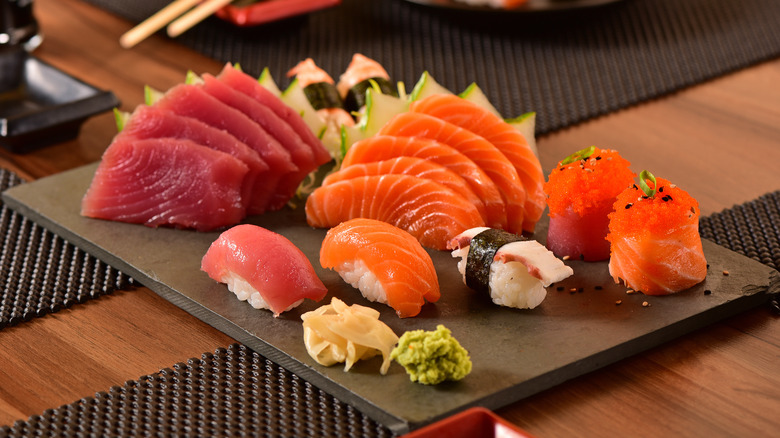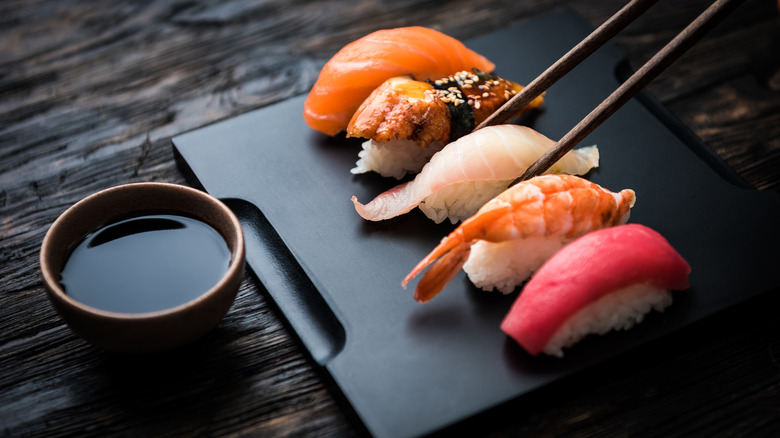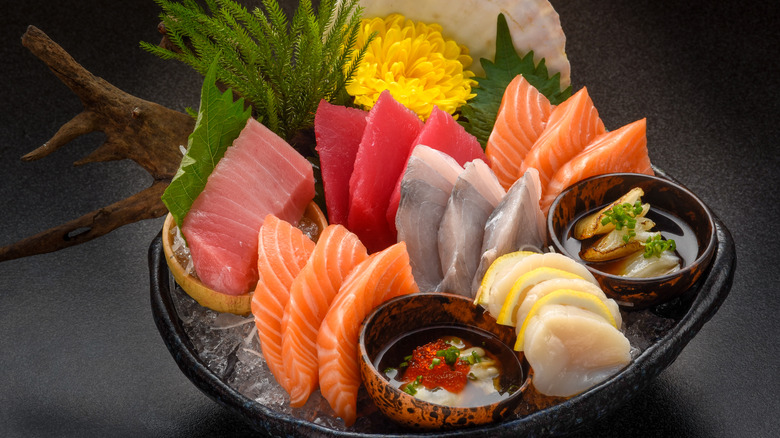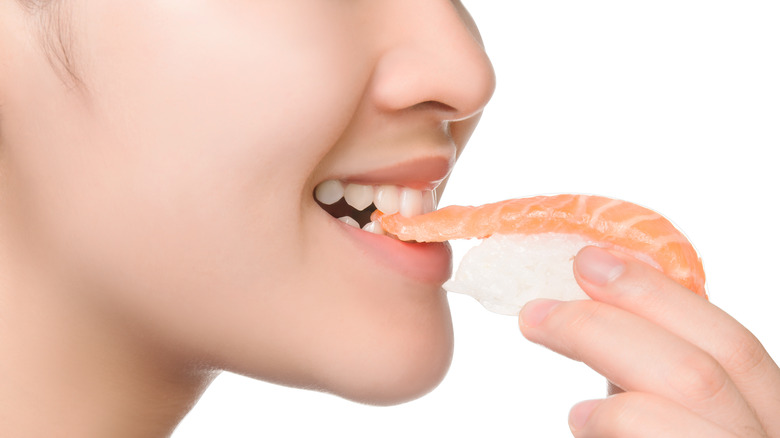The Difference Between Nigiri And Sashimi
Sushi has been around in some form or another since the ninth century as Buddhism spread and many inhabitants looked for food items that didn't contain meat, according to PBS, but it's only in the last 200 years or so that sushi has come to be what we think of it as now: raw fish accompanied by sticky rice (via Matsuhisa Restaurant).
Among the two-thirds of Americans that eat sushi, thanks to a rise in popularity in this country starting in the '70s (as noted by PBS), the most popular type is the one known as makizushi (maki), say the experts at Roka Akor, a national Japanese sushi and steakhouse chain. Makizushi is the Japanese name for what we think of as "sushi rolls" — such as the California roll. Yet, despite the availability of sushi rolls throughout Japan and in Japanese restaurants around the world, they aren't actually authentic Japanese fare. Rather, it's something Japanese chefs in America invented in order to make sushi more palatable to our taste preferences.
The other two types of sushi that are most commonly seen in Japanese restaurants are called nigiri and sashimi, which have their own distinct qualities and best ways to eat them.
Nigiri is the most authentic style of sushi
According to Roka Akor, the name nigiri translates to "two fingers," which can both be a descriptor for its approximate width and length, or the fact that it only requires double digits (or two chopsticks) to eat it. It's comprised of an oval-shaped clump of rice seasoned with wine vinegar, sugar, and salt, and a thinly-sliced and tender piece of fish or seafood that is draped over the block of rice. However, vegetables can also be placed on top as can "tamago," which is a sweet Japanese cooked egg. Sometimes there's also a bit of wasabi between the fish and rice to hold it together.
Descended directly from sushi's original lineage hundreds of years ago — originally it was a combination of fermented fish aged over rice (per Matsuhisa) — nigiri is the only principal form of sushi that you can order that is truly authentic, according to Roka Akor.
If you've never tried nigiri before, you might want to start out with tuna, salmon, or yellowtail, all of which are mild in flavor and offer a more tender chew than some of the other options like shrimp or octopus. To eat nigiri with chopsticks, pick up the whole piece and dip it gently in soy sauce, being careful not to dip the rice-side (via Tsunagu Japan). However, it's perfectly fine to eat nigiri with your fingers, too.
Sashimi is not technically sushi without the rice
The word sashimi means "pierced body" or "pierced meat" in Japanese, per Roka Akor — and that's all it is, just the thinly sliced piece of fish or seafood and nothing else. Though people often confuse it with nigiri, the big difference with sashimi is there's no block of rice, which technically you need to have to qualify it as sushi. Though, it's a great option for those who want the sushi experience but are trying to stay away from extra carbs or who just want the flavor and texture of the protein to shine on its own.
If you've never tried sashimi before, you might want to start with shrimp (which is cooked) or salmon, tuna, or yellowtail, as the latter three are among the most mild in taste and tender in feel of the more common raw fish choices. Though it's not just fish that can be used for sashimi — chicken and beef are options too, says Roka Akor.
The "proper" way to eat sashimi is with chopsticks, according to Tsunagu Japan. They recommend using a chopstick to dab a small amount of wasabi on a piece of sashimi. Then pick up the piece, dip it quickly in soy sauce (do not stir!), and pop the whole piece in your mouth for a one-shot taste explosion rather than take bites of it.
Why you probably should eat nigiri and sashimi at a restaurant
Nigiri and sashimi are both delicious choices at Japanese restaurants all over the world — and they're probably best enjoyed in that setting. According to Benihana, a popular national sushi and seafood chain, this grade of fish is some of the highest quality in the world. They note that there are no nets used in capturing the seafood and it's iced immediately so that it can stay fresh without losing its purity or building up lactic acid. Because of the great preparation that goes into it, including precautions taken within the restaurant, it's safer to eat than trying to perhaps buy raw fish from the market and eat it at home.
Benihana adds that nigiri is almost always made with sashimi-grade fish on top of the rice. Though nigiri isn't alway raw — eel (aka unagi), shrimp, and the aforementioned tamago are all cooked before being placed on the rice. So whatever your taste preference may be, there is a type of sushi — nigiri, sashimi, or maki — waiting for you to enjoy.



